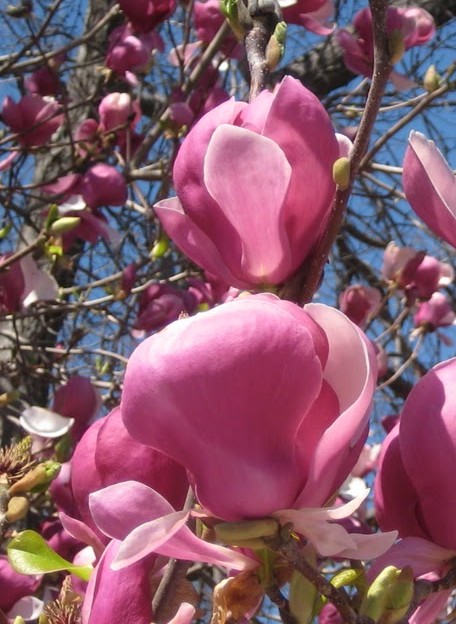 A hybrid of Magnolia heptapeta x Magnolia quinquepeta, saucer magnolia is probably one of the most widely planted and best known of the magnolias. Its popularity may be due to the fact that it flowers well while still small. And the flowers are truly fabulous! Large, cup-shaped, white flushed with reddest purple or pink, the flowers are fragrant and appear in early spring, unless the frost gets them. The compound fruits are 4” long and bear reddish-orange seeds in late summer and early fall. The leaves appear after the flowers, are 3-7” long, and are reddish bronze when they first appear. They turn dark green for summer and yellow-brown in the fall, when they are not particularly ornamental. Although saucer magnolia is a small tree it can be grown as a multi-stemmed shrub with many branches low to the ground. Many cultivars are available that vary in time of bloom, and color from white to pink, and purple. Frost damage to the flower buds is one of the biggest problems when growing these lovely trees. To temper the problem by delaying the development of flower buds, plant them in a protected spot that is not especially warm and sunny in spring. Alternatively, plant one of the late blooming cultivars like ‘Verbanica’. Give them plenty of room so they can develop their normal form.
A hybrid of Magnolia heptapeta x Magnolia quinquepeta, saucer magnolia is probably one of the most widely planted and best known of the magnolias. Its popularity may be due to the fact that it flowers well while still small. And the flowers are truly fabulous! Large, cup-shaped, white flushed with reddest purple or pink, the flowers are fragrant and appear in early spring, unless the frost gets them. The compound fruits are 4” long and bear reddish-orange seeds in late summer and early fall. The leaves appear after the flowers, are 3-7” long, and are reddish bronze when they first appear. They turn dark green for summer and yellow-brown in the fall, when they are not particularly ornamental. Although saucer magnolia is a small tree it can be grown as a multi-stemmed shrub with many branches low to the ground. Many cultivars are available that vary in time of bloom, and color from white to pink, and purple. Frost damage to the flower buds is one of the biggest problems when growing these lovely trees. To temper the problem by delaying the development of flower buds, plant them in a protected spot that is not especially warm and sunny in spring. Alternatively, plant one of the late blooming cultivars like ‘Verbanica’. Give them plenty of room so they can develop their normal form.
Type: Deciduous flowering tree
Outstanding Features: Flowers
Form: Oval to round with maturity
Growth Rate: Moderately fast when young slowing down with maturity
Bloom: Cup-shaped, white tinged with purple to pink, 5-10” wide flowers in early spring
Size: 20-30’ H x 20-30’ W
Light: Full sun to partial shade
Soil: Deep, fertile, high in organic matter, moist, well-drained
Hardiness: Zones 6-9
Care: Leaves and fruits clean up
Pests and Diseases: Relatively disease and pest free but susceptible to leaf spot, canker, scale, sassafras weeveil
Propagation: Seed; cultivars by cuttings.
